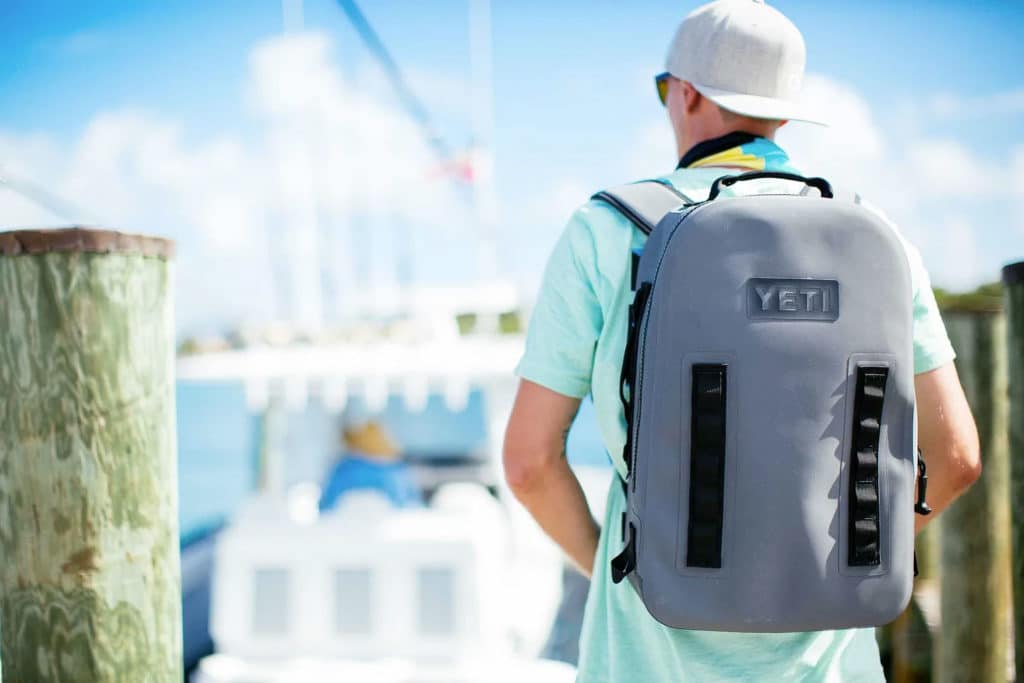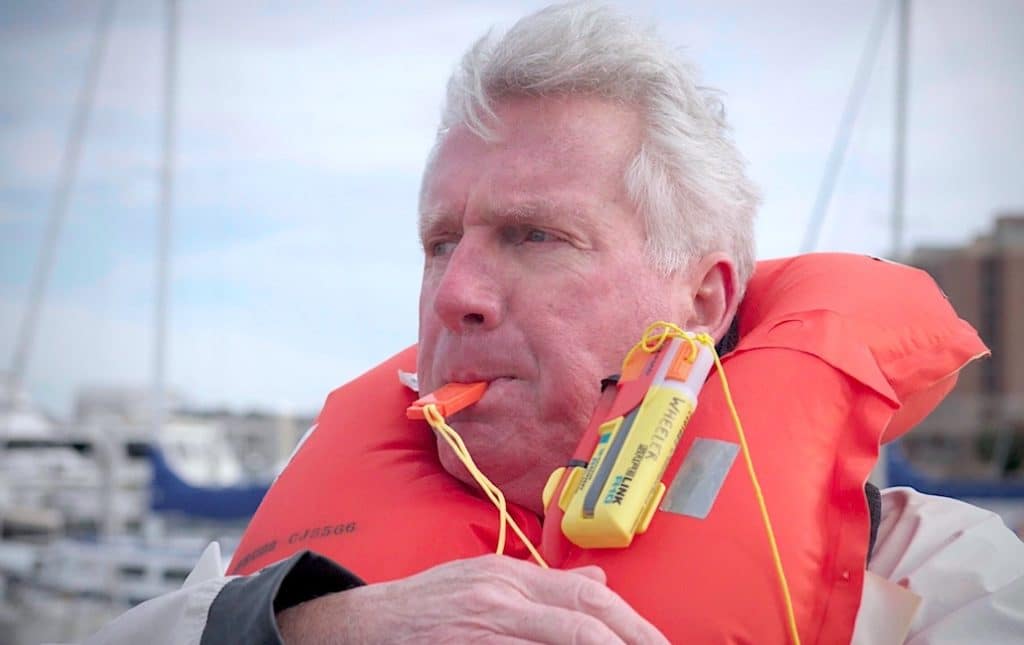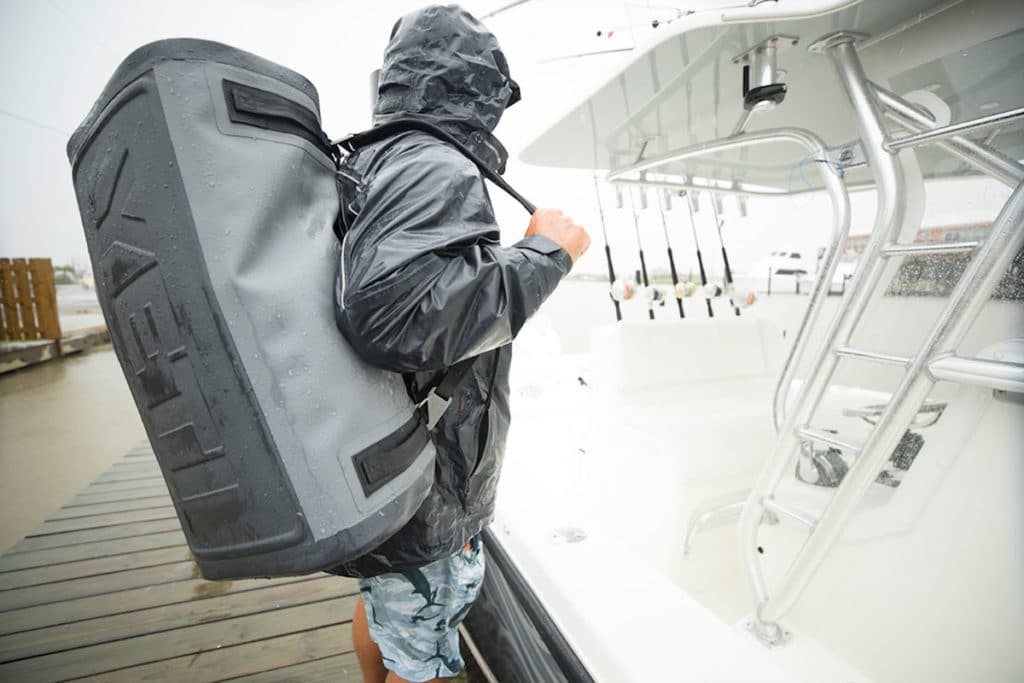Everybody wants to look good on the water. The right board shorts and perfect pair of shades can go a long way, but to complete the look you need the one accessory that instantly identifies you as a serious boater. We’re talking about a well-appointed boating kit, or what old-time sailors called a sea bag.

This isn’t a Ditch Bag stocked with survival essentials, which every vessel should have on board. It’s a personal kit pre-packed with everything you need for a comfortable and safe day on the water.
Most days, you might not have to reach any deeper than the pocket holding your sunscreen. But when that thunder cell opens up in the afternoon, you’ll look awfully good, and comfy, in your foul weather gear. Here are some things to take into consideration as you head out for a day of boating.
Before we move on to what’s in your personal kit, be sure the boat itself is equipped with the U.S. Coast Guard-required safety gear. This includes properly fitting life jackets for everyone on board, a fire extinguisher, a horn and signaling devices. West Marine has a good breakdown of requirements for various sizes and types of boats.
Equipment to Have
- Life jacket. While any boat you step foot on should be supplied with U.S. Coast Guard approved life jackets for everyone aboard, a personal life jacket is a great investment in comfort, safety and style. Make sure it fits properly and is suitable for your kind of boating. If you frequently go offshore, a self-inflating life jacket allows for range of motion and comfort, and provides lots of flotation should you find yourself in the water. Popular brands include Onyx and Mustang Survival, while outdoor stores like Dick’s and West Marine have their own seaworthy brands. If wakeboarding or wake surfing is more your style, you’ll want a life jacket designed for your chosen activity. Be sure your life jacket is U.S. Coast Guard approved, and if it’s inflatable, check that it has a full cylinder and all status indicators on the inflator show green.
- Whistle. A noise-making device is key if you’re in a rescue situation and need to get the attention of anybody nearby. An inexpensive whistle can easily be attached to your life jacket, and could just save your life.

- Flashlight. Waterproof, with fresh batteries.
- Polarized sunglasses. Good shades will not only help protect your eyes from the sun’s rays, but they also make it easier to see objects on and in the water. It’s why anglers swear by them for any and all fishing excursions.
- Sunscreen or zinc. It’s a bad day on the boat if you get offshore and realize nobody packed sunscreen—and it becomes essential if you’re in survival mode in the water, especially for your face. Many brands offer rub-on sticks that can clip to belt loops or straps for convenience.
- UV-protective clothing. Sun shirts are all the rage—especially the lightweight, long-sleeve variety. They are comfortable, breathable and offer all-day protection from the sun. You can find them in a variety of styles and materials, such as a button-up with a collar or a pullover with a hood. Some even have built-in face masks for the ultimate protection while you’re fishing.
- A hat. A brimmed hat is a must-have on a bright sunny day. And when a cold front moves in, a knit cap can make a world of difference.
- Boat-ready shoes. If you’re heading out into an ocean or body of water that has any type of wave action, a shoe with proper sole material and water-sipping designs makes all the difference for grip and safety. Many sport-style boat shoes also feature drainage holes so they dry faster (and so you don’t have to walk around with puddles in your shoes should they get wet). Columbia and Sperry offer a variety of great options.
- Foul weather gear. For most outings, this could be a simple rain shell. These days they are lightweight and easy to pack. Should that unexpected storm cloud roll in, staying warm and dry is priceless. If you’re venturing offshore or in cooler weather, you’ll want to add a pair of waterproof bibs and insulating layers.

- Water bottle. Don’t assume that the captain is always going to have the cooler stocked with water and juice boxes. So be a big boy or girl, and bring your own just in case. Should a situation arise where you’re stranded on the boat for hours or more, it’s always good to have a large, insulated bottle of water on hand to stay hydrated.
- Waterproof Phone Case. Keeping your phone in a waterproof pouch or case is the best way to ensure it’s usable if you need it. Choose one that allows you to use the phone without removing it from the case.
- Handheld VHF radio. If you’re heading offshore, the boat should have a built-in VHF-radio, preferably one with DSC position-reporting capability. But it never hurts to have a backup, and it’s always a good idea to have a VHF unit even on inland waters where it’s not required. With a VHF unit, you can contact emergency services via Channel 16 should the need arise.
- Personal locator beacon. While this might seem overkill for an outing on your home lake, consider it essential for offshore trips or any off-the-beaten path adventures such as hiking, backcountry skiing or civilian aviation. Simply put, if you’re in distress anywhere in the world, this beacon the size of a deck of cards will alert rescue services and give them your precise location using a network of satellites.
- Dry bag. Where are you going to store your handheld radio, water bottle, sunscreen, shoes, battery pack and other gear? In a dry bag, of course. Find one that looks good and works for you, and keep it at the ready for your next boating adventure.
There you have it, a boater’s guide to an easy-to-create, easy-to-take-anywhere boating kit. All of these items are easy to source, and while you may feel like “Capt. Overkill” taking it onto the boat every time, you’ll quickly become “Capt. Lifesaver” if things go sideways. That’s what being prepared is all about—expecting the unexpected and being able to do what’s needed when it happens.
One note as you start building your kit: Make sure you regularly clean and check all of your gear. Salt water can quickly corrode things, and your survival kit will be of no use should the items you need no longer work properly. Fresh batteries and inflation cartridges can be lifesavers – literally. With that, stay safe, stay prepared, and be cool.
The U.S. Coast Guard is asking all boat owners and operators to help reduce fatalities, injuries, property damage, and associated healthcare costs related to recreational boating accidents by taking personal responsibility for their own safety and the safety of their passengers. Essential steps include: wearing a life jacket at all times and requiring passengers to do the same; never boating under the influence (BUI); successfully completing a boating safety course; and getting a Vessel Safety Check (VSC) annually from local U.S. Coast Guard Auxiliary, United States Power Squadrons®, or your state boating agency’s Vessel Examiners. The U.S. Coast Guard reminds all boaters to “Boat Responsibly!” For more tips on boating safety, visit www.uscgboating.org.








